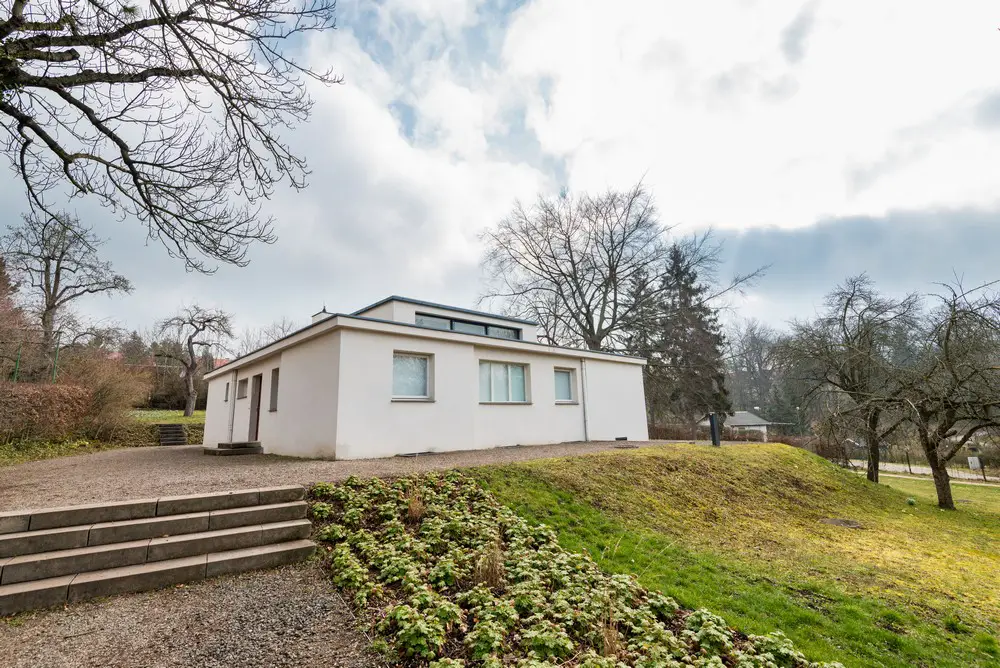Haus am Horn, Weimar Home, World’s First Bauhaus Building, Modern German Architecture, House
Haus am Horn in Weimar
Major 20th Century Architecture in Thuringia, Germany: Architectural Information + Images
8 Aug 2016
Haus am Horn in Weimar, Thuringia, Germany
Haus am Horn – The World’s First Bauhaus Building
Design: Georg Muche & Bauhaus students
The Haus am Horn in Weimar is the first architectural example from the Bauhaus, and the only one in the city where the school was founded
Article first published on Houzz
Eva Zimmermann, Houzz Contributor
Imagine you’re in 1922. Charles Lindbergh’s flight across the Atlantic hasn’t happened yet. Cars still look like horse-drawn carriages. And in Weimar, Germany – the birthplace of German classicism (think Goethe and Schiller) – an avant-garde art school called Bauhaus has, for the past three years, been carrying on in a “crazy” fashion. Why are these people running around in tunics celebrating and meditating on design?
That question and others must have been on the minds of state government leaders when they asked Bauhaus director Walter Gropius to present the early results of the school’s work. Gropius’s answer to the political establishment of Thuringia, which helped subsidise the school, came in the form of the world’s first Bauhaus building, the Haus am Horn. In one week of exhibitions in 1923, the Bauhaus school demonstrated its capacity for innovation with that project and others.
But financial and political pressures led the Bauhaus to leave Weimar for Dessau, Germany, and the house was sold. Haus am Horn survived the dark years of Nazism and World War II. Today, it’s a UNESCO World Heritage site, because it’s the place where the ground-breaking ideas of classic modernism were first on full display.
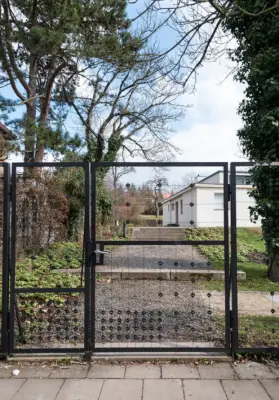
Photo by Kate Jordan Photo – Discover home design design ideas
Haus am Horn at a Glance
What it is The first building erected by the Bauhaus school
Location Weimar, Thuringia, Germany
Size 120 sqm
Designers Georg Muche (architecture) and Bauhaus students, including Marcel Breuer, Gunta Stölzl and Alma Buscher (interior design)
What do we think of when we hear the word Bauhaus today? Most people would probably say “architecture”. The Bauhaus Building and the Masters’ Houses in Dessau are well known. And architects Walter Gropius and Ludwig Mies van der Rohe are associated with the Bauhaus movement. But for Gropius and other Bauhaus participants, it was all about interdisciplinary work.
“The core concept was the reunification of all artistic disciplines,” says Michael Siebenbrodt, director of the Haus am Hornr and curator of the Bauhaus Museum. “At the Bauhaus, everyone worked as part of a team. In all of the workshops, they created standardised products for industrial production. Bauhaus was not about conveying a certain style, for style means imitation. Instead, the Bauhaus was a college for invention.”
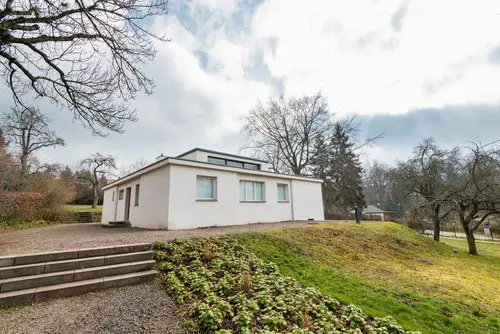
Photo by Kate Jordan Photo – Search contemporary home design pictures
This abundance of invention manifested itself, after just four months of construction, in the Haus am Horn. All of the Bauhaus workshops helped to build and furnish the house, which emerged as a residential prototype.
It was supposed to be the beginning of a Bauhaus village that would be like a university campus today. However, after the state elections of 1924, the power structure in Thuringia changed, and the new conservative administration reduced the school’s budget by 50 percent. In 1925, the Bauhaus moved to Dessau, and the village did not come to pass.
See how the midcentury modern aesthetic grew out of the Bauhaus style
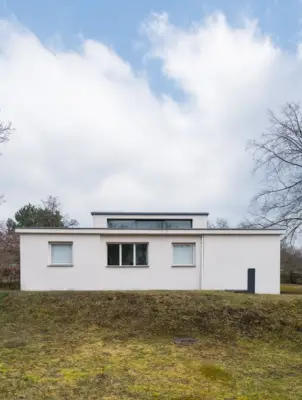
Photo by Kate Jordan Photo – Browse contemporary home design ideas
The experimental Haus am Horn was designed not by an architect, but by a painter and graphic designer, Georg Muche, who was the head of the weaving workshop at the Bauhaus.
Students who later achieved recognition also participated in the project. One was Marcel Breuer, who designed the living room furniture and the furnishings for the “lady’s room”. Marta Erps wove rugs, and Bauhaus master Lászó Moholy-Nagy designed lighting for the “man’s room”.
The building was erected in the Bauhaus garden, where students farmed and produced supplies for the school’s canteen. Innovative materials were used in the building. The wall and ceiling structures are made of lightweight building blocks of cement-bonded slag concrete, which form a double-skin masonry wall with Torfoleum insulation in between. The slim, energy-efficient material saved on transportation and heating expenses.
“We have here what is probably one of the first eco homes in history,” Siebenbrodt says. “Because of the new method of construction, heating costs were reduced by 50 percent compared with other homes of the period.”
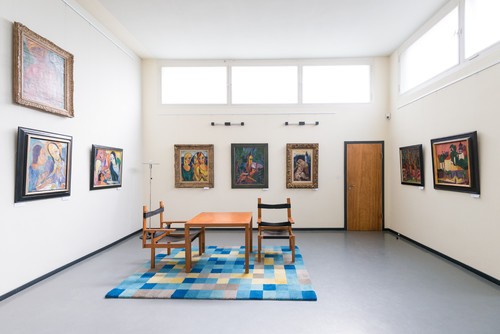
Photo by Kate Jordan Photo – Search contemporary home design design ideas
Oil paintings by Paul Kother, one of the forgotten Expressionists of Weimar, pictured on display in an exhibition at the Haus am Horn in May 2016.
Anyone who visits the Haus am Horn leaves with a new and different understanding of Bauhaus. “‘White modern’ is something that actually never existed in that sense,” Siebenbrodt says. “This picture emerged because of the way the media reported it. Magazines on architecture publicised projects in black and white until well into the 1970s. However, the Bauhaus is a deeply coloured affair.” That was seen then and can be seen now in Haus am Horn.
The building is arranged like a Mediterranean courtyard house, with a room in the middle around which all the other rooms are arranged in a ring. This central living space takes up one-third of the surface area and is illuminated via clerestory windows. Bordering it are the work niche, the man’s room, the bathroom and toilet, the lady’s room, the children’s room, the dining room, the kitchen and the guest room.

By Kate Jordan Photo Berlin – See more Home Design Photos
Siebenbrodt is the chairman of the Circle of Friends for Haus am Horn. His connection to Bauhaus goes back to his childhood. “The Bauhaus scholar Hedwig Huschke was my first drawing teacher. As a boy, I always went to Aunt Huschke’s and sat there on little Bauhaus chairs, eating from little Bauhaus plates.”
Siebenbrodt grew up in the Adlershof section of Berlin in one of the housing complexes designed by former Bauhaus teacher Ludwig Hilberseimer. At the Martin Luther University of Halle-Wittenberg, Expressionist painter and printmaker Conrad Felixmüller was a father-like friend. Bauhaus seemingly was Siebenbrodt’s destiny. The enthusiasm with which he leads us through the rooms is contagious. Here he’s pictured sitting on a reproduction of one of Marcel Breuer’s furniture designs.
The original furniture in the house has long since disappeared. The 1923 exhibition lasted only eight weeks, from 15 August until 30 September. After that, a series of occupants renovated and reconfigured the house again and again.
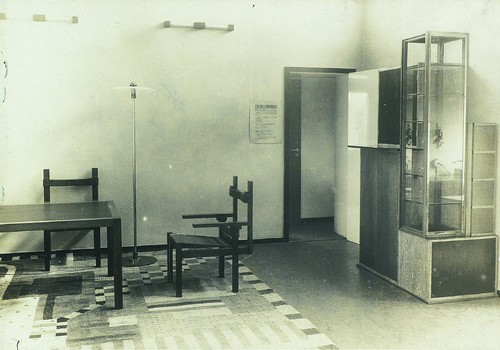
By Eva Zimmermann – See more Home Design Photos
The living room on view at the 1923 exhibition featured a table and chairs designed by Marcel Breuer.
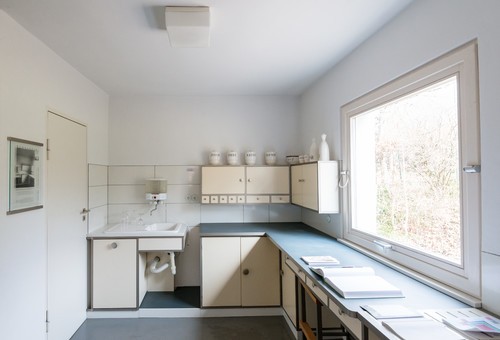
Photo by Kate Jordan Photo – Browse contemporary kitchen photos
Benita Otte designed the built-in kitchen; this is a reconstruction consistent with historical photographs. This kitchen was created three years before Margarete Schütte-Lihotzky’s 1926 Frankfurt kitchen – the prototype of modern built-in kitchens. It’s certainly possible that Schütte-Lihotzky had seen this kitchen or pictures of it. The Association of German Architects moved its 1923 annual convention to Weimar, as a result of which a broad sampling of the profession visited the Haus am Horn. In addition, Gropius’s office director and site manager for the Haus am Horn, Adolf Meyer, later went to Frankfurt, where he worked on the New Frankfurt public housing programme with Ernst May.
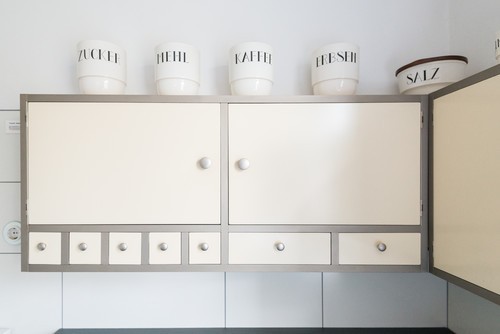
Photo by Kate Jordan Photo – Look for contemporary kitchen pictures
The skirting boards and wall panelling in the kitchen and bathroom are made of semi-translucent opal glass in white, black and red.
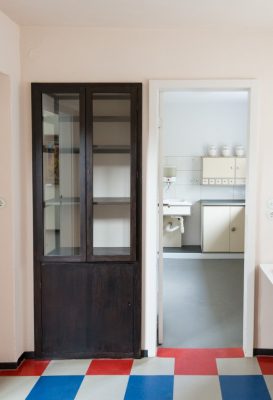
Photo by Kate Jordan Photo – Look for contemporary home design design inspiration
Here is the view from the dining room into the kitchen. The floors of the house were covered with rubber or, as here, a linoleum substitute called Triolin. After World War I, resources were scarce and linoleum was heavily taxed, so Triolin was chosen.
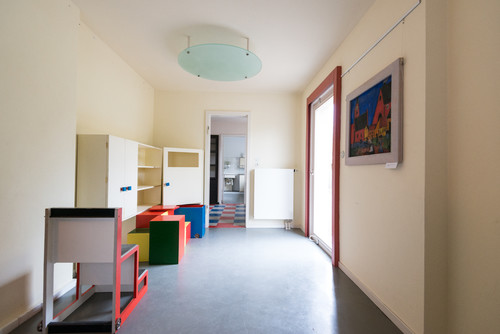
Photo by Kate Jordan Photo – More contemporary kids’ room ideas
“The works on display here all came from students,” Siebenbrodt says. “It’s amazing they were all identified by name, because anything designed by students actually belongs to the school.”
The children’s room was furnished as a multi-functional adventure playground. It was conceived by a student, Alma Buscher, from the wood-carving workshop. She also designed the ceiling light fixture. It was conceived as a cinematographic apparatus and was originally supposed to be lowered by crank so children could place their cardboard cut-outs and similar objects on it.
“Think about the fact that Moholy-Nagy invented his famous Light-Space Modulator shortly after that,” Siebenbrodt says with a wink. “He might have gone through the workshops and allowed himself to be inspired by Buscher’s light.”
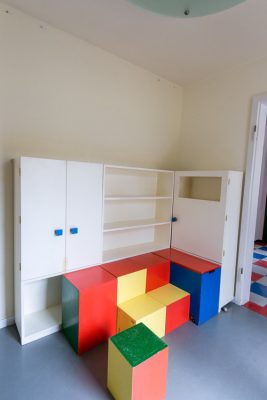
Photo by Kate Jordan Photo – Discover contemporary kids’ room design inspiration
This modular system is older than Le Corbusier’s Modulor. The lowest box is the right height for children. Stand it on edge and you have a table. The big boxes can serve as adult seating. The unit with a closed door and window is not a single-function display case, but becomes, on opening, a puppet theatre. The combinations are almost endless. “And you don’t have to explain it to children, they understand it intuitively,” Siebenbrodt says.
The children’s room is seen on display in 1923.
Michael Siebenbrodt demonstrates the seating height for grown-ups.
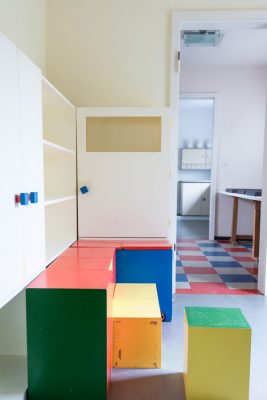
Photo by Kate Jordan Photo – Search contemporary kids’ room pictures
The children’s room system was manufactured briefly by the Bauhaus workshops for kindergarten classrooms. “We searched for a long time for an original preserved example and got lucky a few years ago, when we found one in private possession,” Siebenbrodt says. “Today, it belongs to the Bauhaus Museum. Here you are only looking at a reproduction.”
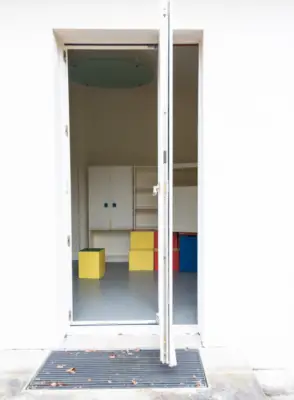
Photo by Kate Jordan Photo – Browse contemporary home design photos
Wooden, side-hung glazed doors, serving also as windows, were fitted in the living rooms, while space-saving bottom-hung windows were chosen for the kitchen – all with polished plate glass. In home construction in 1923, simple window glass punctuated with striations and cavities was generally in use. A quality product was used for the Haus am Horn that was thicker and thus a better heat insulator. Special hinges designed by the Bauhaus students maximised window openings while allowing access to every part of the glass for cleaning.
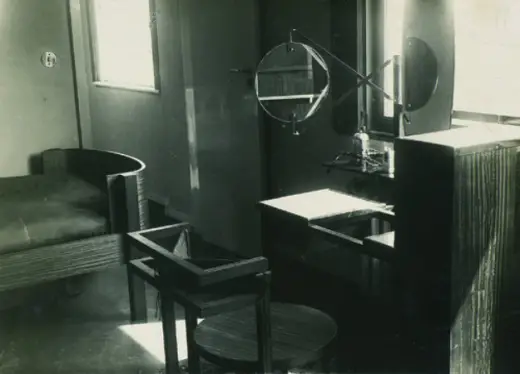
Photo by Kate Jordan Photo – Browse contemporary home design ideas
This is the lady’s room Marcel Breuer designed when he was a student. His built-in closets had been preserved in their original form and were refurbished during the 1998-99 general restoration. Elements of their construction are varnished red, golden yellow and black depending on function.
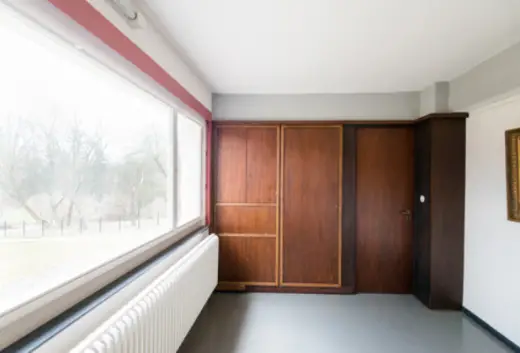
By Eva Zimmermann – See more Home Design Photos
The lady’s room is pictured in 1923; the furniture is by Marcel Breuer.
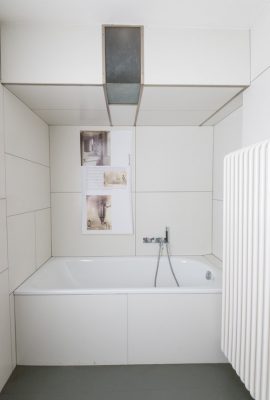
Photo by Kate Jordan Photo – Search contemporary bathroom pictures
The bathroom was lined with large glass panels. These provided a new aesthetic and set hygienic standards still in use today. During reconstruction, the panels were mistakenly reproduced with dark joints.
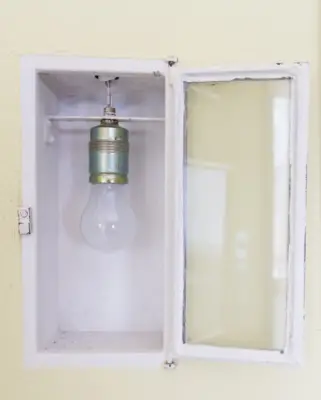
Photo by Kate Jordan Photo – More contemporary home design photos
Integrated lamps were a key part of the furnishings of the Haus am Horn. All of the lighting ideas shown here stem from the original construction.
The central room was lit only by a panoramic window in the work niche and sandblasted clerestory windows. Such reticence was desired and is reminiscent of the Japanese tatami rooms. The Bauhaus teachers, in fact, included elements of Far Eastern meditation techniques in their instruction.
“That is the esoteric aspect of the Bauhaus, whose representatives were painter and designer Johannes Itten and painter and architect Georg Muche,” Siebenbrodt says. “Itten later joined the Mazdaznan sect and also recruited followers at Bauhaus. Back then, Gropius fought strenuously against this, so that their influence would not grow any stronger.”
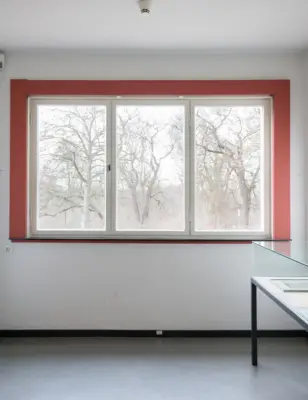
Photo by Kate Jordan Photo – Discover contemporary home design design inspiration
In 1924, the house was sold to a lawyer. The lawyer lived there until 1938 and made changes to the building. He sold it in 1938 to the Deutsche Arbeitsfront DAF, or German Labour Front, the unified organisation of employers and employees during the National Socialist, or Nazi, period. The German Labour Front had proposed to tear down the house and build an education centre, Siebenbrodt says. As the war began, these plans were dropped.
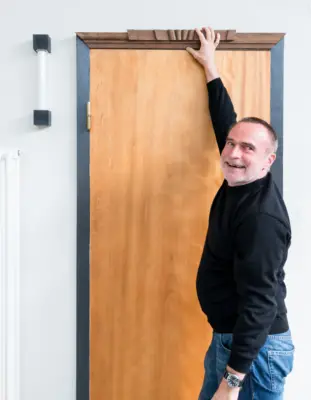
By Kate Jordan Photo Berlin – See more Home Design Photos
Old building components and found pieces of the past are stored in the basement. These bear witness to the fact that not everyone was able to make peace with the straightforward architecture of the house. Note this door frame. “From the late 1930s until 1945, a German Armed Forces officer lived here, and he allowed the simple door frame to be adorned with an oak ornament in rustic fashion,” Siebenbrodt says.
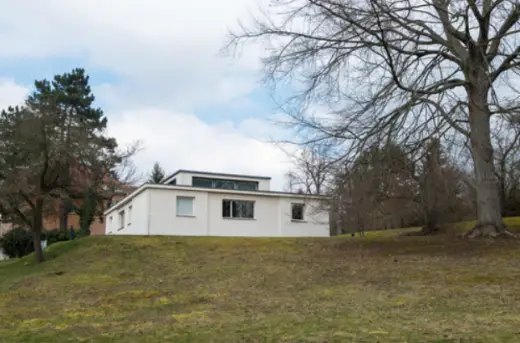
Photo by Kate Jordan Photo – Look for contemporary home design pictures
Haus am Horn survived the changes and remains standing today. After World War II, the property was transferred to the city of Weimar. A Bauhaus University professor lived there with his family for many years. In 1996, the Haus am Horn and other Bauhaus sites were declared a UNESCO World Heritage site.
Weimar citizens have grown proud of the “crazy” artists of yesteryear and the fact that one of the most influential schools of the 20th century was founded in their city. The Haus am Horn was renovated, and today the building’s leaseholder is the Circle of Friends of the Bauhaus University in Weimar. In 2017, the house will be transferred as part of the Bauhaus Museum to the Weimar Classics Foundation.
Bauhaus Buildings
Bauhaus Architecture – selection on e-architect
20 Feb 2017
Villa Harnischmacher II, Germany
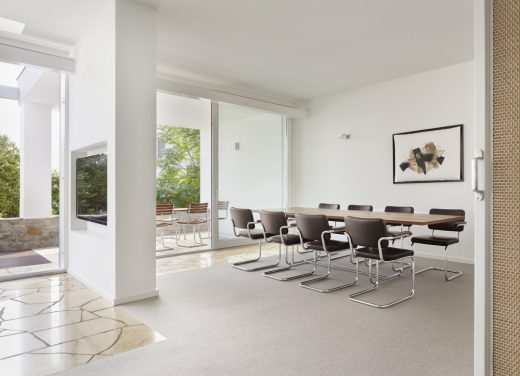
image courtesy of architects
Villa Harnischmacher II,
An iconic Bauhaus villa in Wiesbaden’s city centre by Marcel Breuer in 1954 sets the ideal stage for the tubular steel furniture that he designed in the late 1920s for the Frankenberg-based company.
These classic Breuer designs are supported by a sympathetic cast of contemporary designs from the Thonet portfolio. The bungalow is Breuer’s only existing example of a residential home in Germany and is considered an outstanding work of modern architecture. The clear, open and simple design of the Thonet furniture harmoniously merges with the elegantly discreet and highly functional layout of the house.
Bauhaus Archiv Berlin Museum of Design, Germany
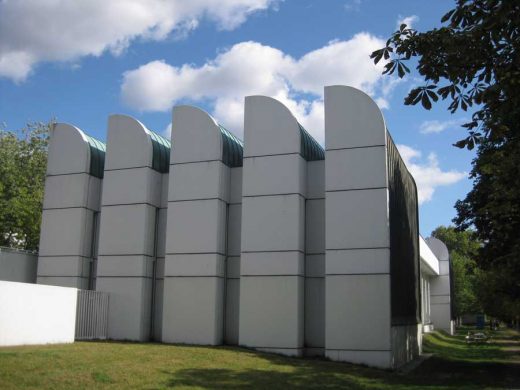
photo © Adrian Welch
Walter Gropius Architect
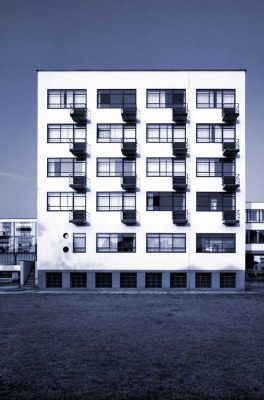
picture © Gordon Watkinson
Bauhaus School Building in Dessau
Bauhaus Building, Walter Gropius, 1925-26, Dessau, Germany
Gropius in Chicago Coalition Protest, USA – Michael Reese Hospital Laundry building:
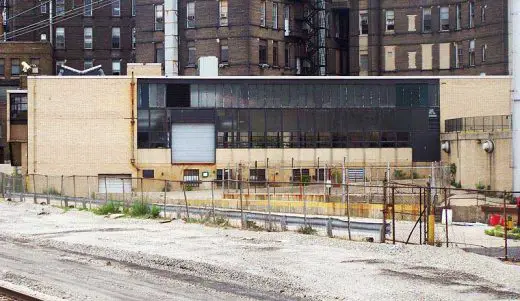
photograph © Grahm M. Balkany / Gropius in Chicago Coalition
Bauhaus Museum Dessau Competition, Germany
Bauhaus in America Exhibition and Conference
Hazel Larsen Archer, Buckminster Fuller’s 1949 Dome at Black Mountain College, Summer 1949, gelatin silver prints, 13.75 x 21 inches (overall), 3.875 x 3.875 inches (ea):

photograph © Estate of Hazel Larsen Archer
bauhouse 24H Competition, Dessau, Germany
1st prize: Sonya Falkovskaia
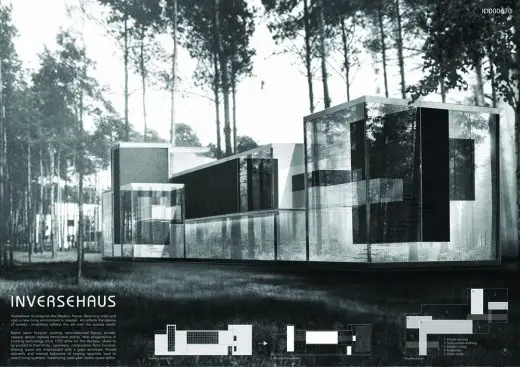
image courtesy of designer / 24h
bauhouse Competition – 28 Jun 2017
Bauhaus Masterhouses Dessau, Germany
Experimental steel & concrete cubic house listed as World Heritage site, designed by Georg Muche.
Address: Am Horn 61, 99425 Weimar, Germany
Phone: +49 3643 583000
Modern Architecture
Major Modern Buildings
Phillips Exeter Academy Library, Exeter, New Hampshire, USA
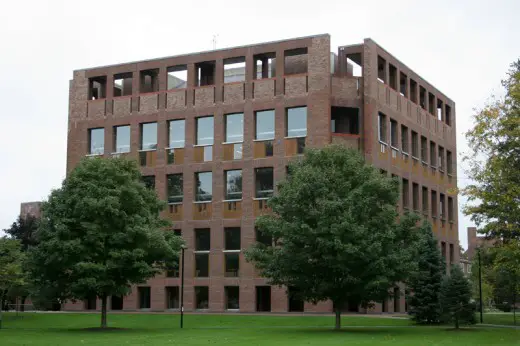
photograph by Rohmer at en.wikipedia
Phillips Exeter Academy Library
Yale University Art Gallery
Louis Kahn / Polshek Partnership Architects, LLP
Yale University Art Gallery
German Architecture
Loft Bauhaus, Brazil
Comments / photos for the Haus am Horn in Weimar: First Bauhaus Building – 20th Century Thuringia Architecture, Germany: page welcome

